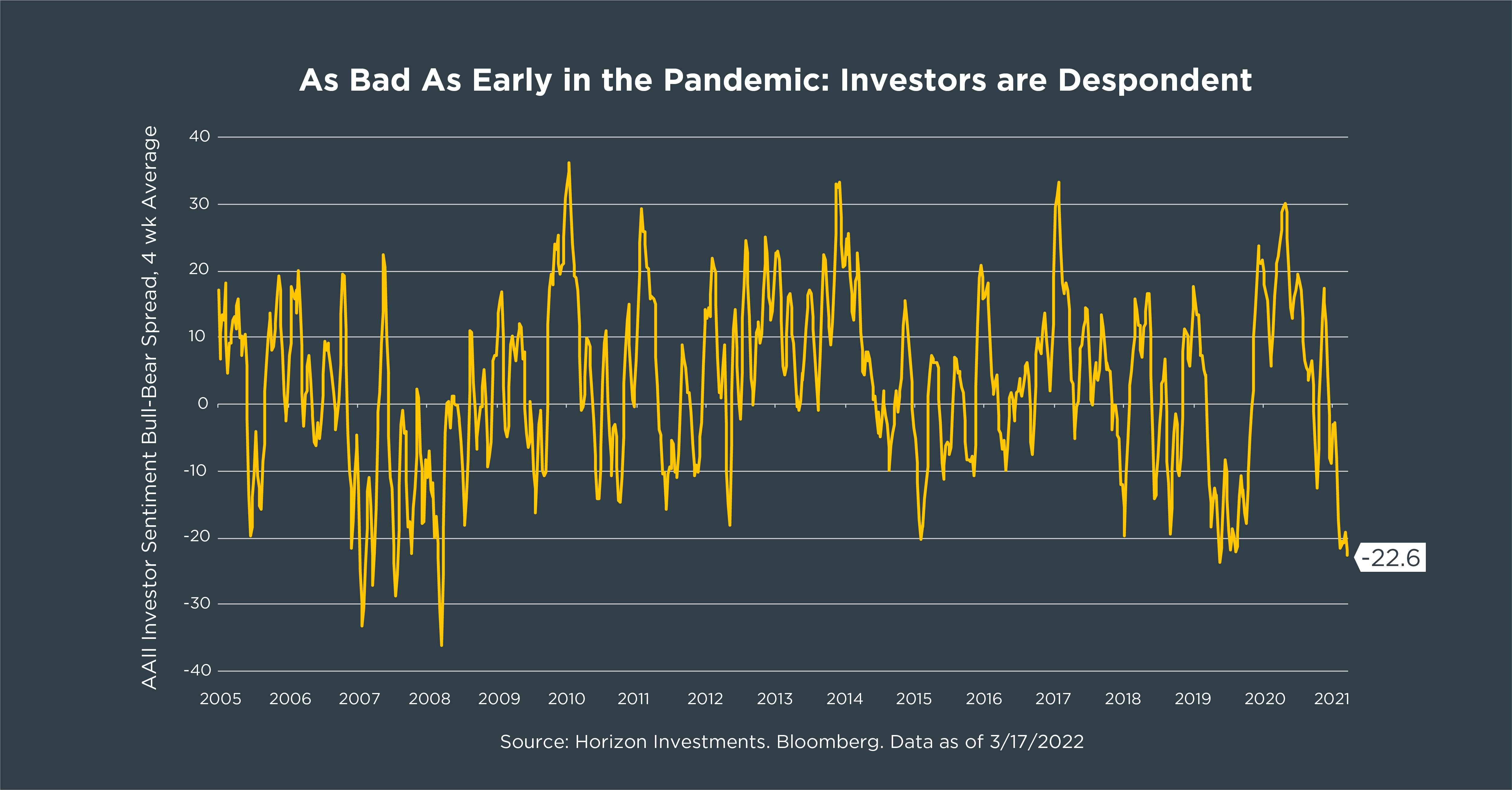Investors sure are a gloomy bunch these days.
How downbeat are they? According to the AAII Investor Sentiment Survey1 (a weekly
poll measuring individual investors’ outlook for the equity market), for the week ending
3/16/2022, investors’ bearish sentiment—the outlook that stock prices will fall over the
next six months—rose to 49.8%, versus its historical average of just 30.5%.
Even more telling: The gap between bullish sentiment and bearish sentiment—known
as the bull-bear spread—clocked in at a shockingly low –22.6 percentage points (on a
4-week moving average basis), as seen in the chart.

Notice that the last time investors saw a 4-week spread that dipped below -20
percentage points was shortly after the pandemic started—and you have to go all the
way back to the 2007-2008 global financial crisis to find a larger negative spread!
So it might surprise your clients to learn that all this negativity could mean good things
for their wealth—if they’re positioned properly.
The reason: Historically, stocks have rallied after investor sentiment turned south.
Following periods when the bull-bear spread was -10 percentage points or more (on a
4-week moving average basis), the S&P 500 on average posted the following returns:
● 8 weeks out: 3.4%
● 12 weeks out: 5.1%
● 52 weeks out: 15.5%
We believe the recent extremes in investor sentiment help to put stock market
performance of late—such as the S&P 500’s 6.1% rally last week—into context. The
shock to valuations stemming from the rapid changes in Fed expectations has clearly
hurt sentiment. As a result, stock prices have corrected lower for much of 2022.
But investors have now appeared to digest these changes, which likely means the worst
is behind us. However, that benign scenario rests on the idea that both economic and
corporate fundamentals must remain healthy.
We will be watching carefully to see whether consumers continue to spend or instead
pull back consumption due to factors such as higher inflation and the Russian invasion
of Ukraine. Corporate earnings growth will be impacted largely by how consumers
respond going forward, and it’s worth noting that the market still foresees healthy
corporate earnings for the year.
Should the expected strength in corporate earnings come to fruition, it would support
investors’ use of equity allocations to meet long-term goals–particularly in an
environment of higher inflation and suppressed interest rates. However, the possibility
that consumers could potentially rein in their spending would make the case for risk
management strategies aimed at limiting drawdowns among investors who need to
access their funds in the near term.
1 Strategy Spotlight: Why We Think US Equities Had A Good Week; RBC Capital Markets, LLC, March 21, 2022 by Lori Calvasina (Head of U.S. Equity Strategy)
This commentary is written by Horizon Investments’ asset management team. For additional commentary and media interviews, contact Chief Investment Officer Scott Ladner at 704-919-3602 or sladner@horizoninvestments.com.
Nothing contained herein should be construed as an offer to sell or the solicitation of an offer to buy any security. This report does not attempt to examine all the facts and circumstances that may be relevant to any company, industry or security mentioned herein. We are not soliciting any action based on this document. It is for the general information of clients of Horizon Investments, LLC (“Horizon”). This document does not constitute a personal recommendation or take into account the particular investment objectives, financial situations, or needs of individual clients. Before acting on any analysis, advice or recommendation in this document, clients should consider whether the security in question is suitable for their particular circumstances and, if necessary, seek professional advice. Investors may realize losses on any investments. Index information is intended to be indicative of broad market conditions. The performance of an unmanaged index is not indicative of the performance of any particular investment. It is not possible to invest directly in an index.
Past performance is not a guide to future performance. Future returns are not guaranteed, and a loss of original capital may occur. This commentary is based on public information that we consider reliable, but we do not represent that it is accurate or complete, and it should not be relied on as such. Opinions expressed herein are our opinions as of the date of this document. These opinions may not be reflected in all of our strategies. We do not intend to and will not endeavor to update the information discussed in this document. No part of this document may be (i) copied, photocopied, or duplicated in any form by any means or (ii) redistributed without Horizon’s prior written consent.
Other disclosure information is available at hinubrand.wpengine.com.
Horizon Investments and the Horizon H are registered trademarks of Horizon Investments, LLC
©2022 Horizon Investments LLC

